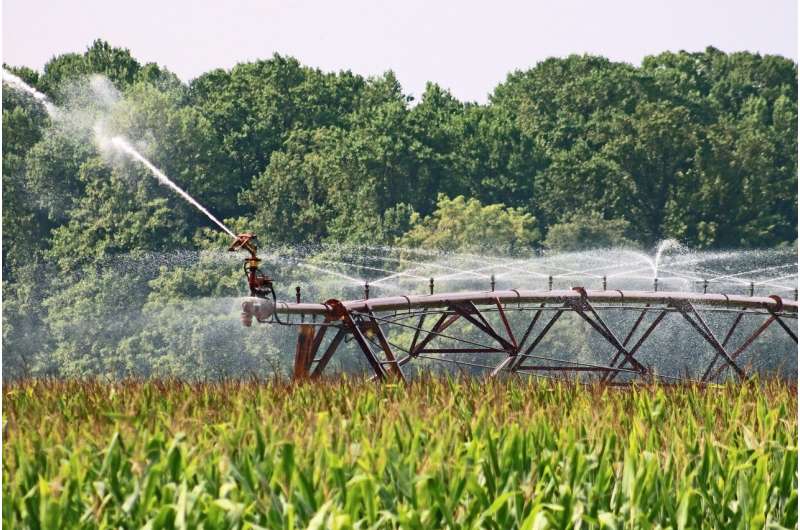This article has been reviewed according to Science X's editorial process and policies. Editors have highlighted the following attributes while ensuring the content's credibility:
fact-checked
peer-reviewed publication
trusted source
proofread
Kawasaki disease linked to air pollution from intensive agriculture and urban emissions

A study led by ISGlobal shows that the incidence of Kawasaki disease in Japan increases when fine metal-laden aerosols are detected in the atmosphere. These aerosols come from the area known as the "breadbasket of China," where grain is intensively cultivated, and combine with air from highly polluted urban centers in South Asia.
Kawasaki disease is still a poorly understood childhood illness. It is thought to occur when an unidentified pathogen enters the upper respiratory tract and causes a dramatic immune response in certain genetically predisposed children. In 20–25% of cases, coronary artery aneurysms develop and, in rare cases, children can suffer sudden death or heart attack years later. In most cases, however, it presents as a rash and fever syndrome that is often mistaken for other, more benign conditions. Hence the risk.
What causes Kawasaki disease?
The causes of the disease are not well understood, although possible triggers include environmental, biological or chemical factors (e.g. bacteria, fungi, viruses, toxins, dust, pollution). The environmental factor seems clear because the disease has a seasonal pattern and cases seem to cluster: for example, in the Northern Hemisphere winter, cases increase in places on both sides of the North Pacific Ocean, coinciding with the seasonal increase in wind currents from the Asian continent.
"The peaks of Kawasaki disease always occur in full synchrony with the arrival of very small particles (less than 1 µm; PM1), which shows that ultrafine aerosols, which can travel long distances, appear to be a necessary co-factor, among other still unknown factors, for the appearance of this disease," explains Xavier Rodó, ISGlobal researcher and first author of the study published in Environmental Research Letters
High-resolution optical measurements
The study used data from the Asian Dust and Aerosol Lidar Observation Network (AD-Net), which routinely monitors air pollution from dust and aerosols at about 20 sites in East Asia. But because air quality stations do not have detailed data on metals (few do), the research team also used a daily aerosol chemical composition survey conducted in Kumamoto Prefecture, Japan, for 37 consecutive days in spring 2011.
This daily study included nearly 60 major and trace elements (mostly metals and metalloids) determined from air filter samples. As in previous studies, the origin of the aerosols was traced back to the Northeast Asian region using Lagrangian simulations of particle models.
More pollution, more hospitalizations
"We compared all the air trajectories and the regions of origin of these air masses between the days of highest and lowest Kawasaki disease," explains Alejandro Fontal, researcher at ISGlobal and last author of the study. The team found a clear temporal relationship between the metals and metalloids recorded in the 37-day interval and the evolution of the number of children admitted to Kumamoto hospitals with Kawasaki disease.
The peak days coincide with episodes of high pollution from the mainland, when fine sulfate aerosols arrive with higher ambient concentrations of lead, arsenic, zinc and bismuth. "An increase of about 70 ng/m3 in the concentration of total metals and metalloids is associated with the occurrence of one new case of Kawasaki disease," continues Fontal.
However, when atmospheric cleansing marine air enters the atmosphere, as indicated by peaks of sodium chloride (NaCl), the influence of the Asian continent is removed and days with low levels of Kawasaki disease occur. These marine aerosols are associated with minimal levels of the most toxic elements such as arsenic, lead, bismuth and cadmium.
An early warning system for Kawasaki disease
The detailed analysis of daily changes in disease and aerosols analyzed in Kumamoto over 37 days, the extreme consistency between the concentration of fine particles from 1970 to 2016 and the incidence of Kawasaki disease in Japan, has helped the researchers to develop a long-term statistical approach. Japan has had a continuous record of epidemiological incidence of Kawasaki disease since the 1970s.
The study's finding is important, says Rodó, because it shows that, "the analysis of the content of fine particles suspended in the air (aerosols), those that are more breathable and can penetrate further into the lungs, and their content in metals (with inflammatory capacity) could serve as an early warning system to prevent episodes of increased cases of Kawasaki disease."
More information: Xavier Rodó et al, Sub-weekly signatures relate ultrafine aerosols enriched in metals from intensive farming and urban pollution to Kawasaki disease, Environmental Research Letters (2023). DOI: 10.1088/1748-9326/acd798




















